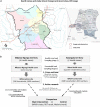Malaria rapid diagnostic test (HRP2/pLDH) positivity, incidence, care accessibility and impact of community WASH Action programme in DR Congo: mixed method study involving 625 households
- PMID: 33639932
- PMCID: PMC7913406
- DOI: 10.1186/s12936-021-03647-9
Malaria rapid diagnostic test (HRP2/pLDH) positivity, incidence, care accessibility and impact of community WASH Action programme in DR Congo: mixed method study involving 625 households
Abstract
Background: Malaria is one of the most prevalent and deadliest illnesses in sub-Saharan Africa. Despite recent gains made towards its control, many African countries still have endemic malaria transmission. This study aimed to assess malaria burden at household level in Kongo central province, Democratic Republic of Congo (DRC), and the impact of community participatory Water, Sanitation and Hygiene (WASH) Action programme.
Methods: Mixed method research was conducted in two semi-rural towns, Mbanza-Ngungu (a WASH action site) and Kasangulu (a WASH control site) in DRC between 1 January 2017 through March 2018, involving 625 households (3,712 household members). Baseline and post-intervention malaria surveys were conducted with the use of World Bank/WHO Malaria Indicator Questionnaire. An action research consisting of a six-month study was carried out which comprised two interventions: a community participatory WASH action programme aiming at eliminating mosquito breeding areas in the residential environment and a community anti-malaria education campaign. The latter was implemented at both study sites. In addition, baseline and post-intervention malaria rapid diagnostic test (RDT) was performed among the respondents. Furthermore, a six-month hospital-based epidemiological study was conducted at selected referral hospitals at each site from 1 January through June 2017 to determine malaria trend.
Results: Long-lasting insecticide-treated net (LLIN) was the most commonly used preventive measure (55%); 24% of households did not use any measures. Baseline malaria survey showed that 96% of respondents (heads of households) reported at least one episode occurring in the previous six months; of them only 66.5% received malaria care at a health setting. In the Action Research, mean incident household malaria cases decreased significantly at WASH action site (2.3 ± 2.2 cases vs. 1.2 ± 0.7 cases, respectively; p < 0.05), whereas it remained unchanged at the Control site. Similar findings were observed with RDT results. Data collected from referral hospitals showed high malaria incidence rate, 67.4%. Low household income (ORa = 2.37; 95%CI: 1.05-3.12; p < 0.05), proximity to high risk area for malaria (ORa = 5.13; 95%CI: 2-29-8.07; p < 0.001), poor WASH (ORa = 4.10; 95%CI: 2.11-7.08; p < 0.001) were predictors of household malaria.
Conclusion: This research showed high prevalence of positive malaria RDT among the responders and high household malaria incidence, which were reduced by a 6-month WASH intervention. DRC government should scale up malaria control strategy by integrating efficient indoor and outdoor preventive measures and improve malaria care accessibility.
Keywords: Democratic republic of congo; Household malaria; Incidence; Malaria care; Rapid diagnostic test.
Conflict of interest statement
The authors have no conflict of interest related to this study.
Figures






Similar articles
-
Environmental and sociodemographic factors associated with household malaria burden in the Congo.Malar J. 2019 Feb 26;18(1):53. doi: 10.1186/s12936-019-2679-0. Malar J. 2019. PMID: 30808360 Free PMC article.
-
Individual, household and neighborhood risk factors for malaria in the Democratic Republic of the Congo support new approaches to programmatic intervention.Health Place. 2021 Jul;70:102581. doi: 10.1016/j.healthplace.2021.102581. Epub 2021 May 18. Health Place. 2021. PMID: 34020231 Free PMC article.
-
Long-lasting insecticidal net (LLIN) ownership, use and cost of implementation after a mass distribution campaign in Kasaï Occidental Province, Democratic Republic of Congo.Malar J. 2017 Jan 9;16(1):22. doi: 10.1186/s12936-016-1671-1. Malar J. 2017. PMID: 28068989 Free PMC article.
-
Case-area targeted preventive interventions to interrupt cholera transmission: Current implementation practices and lessons learned.PLoS Negl Trop Dis. 2021 Dec 17;15(12):e0010042. doi: 10.1371/journal.pntd.0010042. eCollection 2021 Dec. PLoS Negl Trop Dis. 2021. PMID: 34919551 Free PMC article.
-
Prevention of human exposure to livestock faecal waste in the household: a scoping study of interventions conducted in sub-Saharan Africa.BMC Public Health. 2023 Aug 24;23(1):1613. doi: 10.1186/s12889-023-16567-x. BMC Public Health. 2023. PMID: 37612675 Free PMC article.
References
MeSH terms
Substances
Grants and funding
LinkOut - more resources
Full Text Sources
Other Literature Sources
Medical

